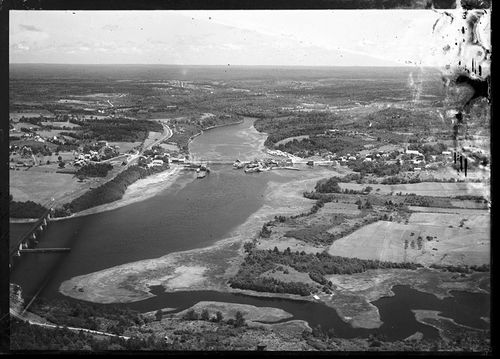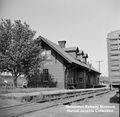Dominion Atlantic Railway Digital Preservation Initiative - Wiki
Use of this site is subject to our Terms & Conditions.
Difference between revisions of "Weymouth"
Dan Conlin (talk | contribs) (first wig wag signal on the DAR) |
|||
| (34 intermediate revisions by 5 users not shown) | |||
| Line 1: | Line 1: | ||
| + | __NOTOC____NOTITLE__ | ||
=Weymouth, Nova Scotia= | =Weymouth, Nova Scotia= | ||
| − | Subdivision Yarmouth, Mile 41.4 | + | [[:Category:Subdivision Yarmouth|Yarmouth Subdivision]], Mile 41.4<br> |
| − | [[ | + | Next Station East: [[Sissiboo Falls]]<br> |
| + | Next Station West: [[Church Point]] | ||
| + | [[File:Weymouth Aerial Oblique.jpg|thumb|500px|right|[[Weymouth]] from the air, 1931. Railway station middle left. Railway bridge lower left. Courtesy Nova Scotia Archives]]. | ||
| + | Apart from Digby which had enough activity to employ a switcher steam engine that also switched the wharf, Weymouth was probably the busiest DAR station between Yarmouth & Annapolis. | ||
| + | |||
| + | Weymouth had 3 saw mills and thus there was lots of lumber shipped by train. Upriver the [[Sissiboo Pulp and Paper|Sissiboo Pulp & Paper Company]] operated a pulp mill from 1904 to 1928 which included a short branch line to Weymouth in operation from 1894 to 1928. There were several automobile cars for GM & Ford dealerships and several tank cars for the ESSO dealership. Beer was delivered by train in boxcars as well as feed for livestock. Some furniture & pleasure boats were shipped from a local industry. There was a small mill that made wooden barrels for rum and other commodities. The station agent name was “Robbie Hill” who lived above the station with his wife & daughter. | ||
| + | |||
| + | There were 5 daily trains a day: Mixed freight and passenger - one westbound in the early morning and the other, eastbound in the evening. Two passenger trains: [[Train No. 98|No. 98]] eastbound in the late morning and [[Train No. 95|No. 95]] westbound in the afternoon. The daily way freight was very busy switching the yard & industries. The freight would arrive around noontime from Yarmouth and would take on water. The engine crew would have lunch while the brakemen would unload freight items from a box car ahead of the caboose into the station on a moveable ramp with dollies. Most of the time the freight would back up onto the bridge to finish switching and to get a good run to climb the grade eastbound (1.5) out of Weymouth. It would then try and make a meet at North Range with [[Train No. 95|No. 95]]. The way freight crew would sleep in Annapolis along with the crew from Kentville and exchange trains and engines the next morning for the return trip to the originating terminals. | ||
| + | |||
| + | The Weymouth bridge spanned the Sissiboo River which had a center span that opened to allow smaller ships to enter the small Weymouth harbor where they docked at the Government Wharf and loaded lumber & pulp wood. There was a bridge tender person named Restaire Gaudet who would walk the bridge for inspection after the trains passed in the day time and was also responsible for opening the bridge for the ships with the use of a bar (key) attached to a gear system. I had the opportunity to help him with this chore on several occasions. As well, torpedoes were placed on the tracks on both sides of the bridge for the protection of trains or section cars. The westbound trains also climbed a grade on the other side of the bridge as Weymouth was in a dip or bowl. The water tower was on the west grade. This meant that the trains eastbound that stopped for water were going down grade and had to be ready to stop for the spout. On rainy day or wet rails, the westbound trains often had wheel slippage & the impressive sound was heard for a long time until the grade was achieved.<ref>Recollections of Albert Melanson. Received by email 2020-06-12</ref> | ||
| + | |||
| + | The Highway No. 1 level crossing at Weymouth received the DAR's first set of wigwag warning signals and bell in April 1937<ref>''[[:Category:The Advertiser|The Advertiser]]'', Feb. 18, 1937 and April 22, 1937</ref> | ||
==Features== | ==Features== | ||
*[[Weymouth Station]] | *[[Weymouth Station]] | ||
| + | *[[Weymouth Water Tower]] | ||
| + | *[[Weymouth Section House]] | ||
| + | *[[Sissiboo River Bridge]] | ||
| + | |||
| + | ==Commerce== | ||
| + | *[[Sissiboo Pulp and Paper|Sissiboo Pulp & Paper Co.]] | ||
==Gallery== | ==Gallery== | ||
<Gallery> | <Gallery> | ||
| + | File:Yar5.JPG|[[Bird's Eve View of Yarmouth Nova Scotia 1889]]: detail of [[Weymouth]], with [[Weymouth Station]] and the [[Sissiboo River Bridge]], 1889. | ||
| + | File:Sissiboo.jpg|[[Weymouth]] seen in the background circa 1907 from the [[Sissiboo River Bridge]], a [[:Category:Nova Scotia Museum|Nova Scotia Museum]] collection postcard. | ||
| + | File:YA-41.35 Weymouth.jpg|A clip of the March 18, 1918 [[:Category:Track_Charts|C.P.R. track profile drawing]] showing Weymouth. | ||
| + | File:Weymouth Aerial Oblique.jpg|[[Weymouth]] and the [[Sissiboo River Bridge]] from the air, July 29, 1931. Railway station middle left. Railway bridge lower left. | ||
| + | File:201216192.jpg|[[Weymouth]] from the air with the [[Weymouth Station]] at centre, July 29, 1931. | ||
| + | File:201216191.jpg|[[Weymouth]] Falls ([[Sissiboo Falls]]) with the [[Sissiboo Pulp and Paper]] company plant, dam and abandoned short line railway tracks at lower centre, July 29, 1931. | ||
| + | File:Weymouth 21 A5 West.jpg|Topographical map of the [[Weymouth]] area including the 1919-1928 branch line to the [[Sissiboo Pulp and Paper]] Company, 1950. | ||
| + | File:DAR - Weymouth Station A - Harold Jenkins Photo - Time 1730 18June1961.JPG|[[Weymouth Station]] and surroundings, June 18, 1961. | ||
| + | Image:Weymouth.jpg|1978 aerial photo of [[Weymouth]] | ||
| + | Image:Weymouth 11-6-78.jpg|D.A.R. trackage in Weymouth on November 6, 1978. | ||
| + | File:Weym10032.JPG|[[Weymouth]] VIA Rail shelter, looking railway east. April 1986. | ||
</Gallery> | </Gallery> | ||
| + | |||
| + | ==References and Footnotes== | ||
| + | <references /> | ||
| + | |||
[[Category:Locations]] | [[Category:Locations]] | ||
| − | [[Category:Subdivision Yarmouth| | + | [[Category:Subdivision Yarmouth|Y414]] |
Latest revision as of 17:44, 18 July 2024
Weymouth, Nova Scotia
Yarmouth Subdivision, Mile 41.4
Next Station East: Sissiboo Falls
Next Station West: Church Point

.
Apart from Digby which had enough activity to employ a switcher steam engine that also switched the wharf, Weymouth was probably the busiest DAR station between Yarmouth & Annapolis.
Weymouth had 3 saw mills and thus there was lots of lumber shipped by train. Upriver the Sissiboo Pulp & Paper Company operated a pulp mill from 1904 to 1928 which included a short branch line to Weymouth in operation from 1894 to 1928. There were several automobile cars for GM & Ford dealerships and several tank cars for the ESSO dealership. Beer was delivered by train in boxcars as well as feed for livestock. Some furniture & pleasure boats were shipped from a local industry. There was a small mill that made wooden barrels for rum and other commodities. The station agent name was “Robbie Hill” who lived above the station with his wife & daughter.
There were 5 daily trains a day: Mixed freight and passenger - one westbound in the early morning and the other, eastbound in the evening. Two passenger trains: No. 98 eastbound in the late morning and No. 95 westbound in the afternoon. The daily way freight was very busy switching the yard & industries. The freight would arrive around noontime from Yarmouth and would take on water. The engine crew would have lunch while the brakemen would unload freight items from a box car ahead of the caboose into the station on a moveable ramp with dollies. Most of the time the freight would back up onto the bridge to finish switching and to get a good run to climb the grade eastbound (1.5) out of Weymouth. It would then try and make a meet at North Range with No. 95. The way freight crew would sleep in Annapolis along with the crew from Kentville and exchange trains and engines the next morning for the return trip to the originating terminals.
The Weymouth bridge spanned the Sissiboo River which had a center span that opened to allow smaller ships to enter the small Weymouth harbor where they docked at the Government Wharf and loaded lumber & pulp wood. There was a bridge tender person named Restaire Gaudet who would walk the bridge for inspection after the trains passed in the day time and was also responsible for opening the bridge for the ships with the use of a bar (key) attached to a gear system. I had the opportunity to help him with this chore on several occasions. As well, torpedoes were placed on the tracks on both sides of the bridge for the protection of trains or section cars. The westbound trains also climbed a grade on the other side of the bridge as Weymouth was in a dip or bowl. The water tower was on the west grade. This meant that the trains eastbound that stopped for water were going down grade and had to be ready to stop for the spout. On rainy day or wet rails, the westbound trains often had wheel slippage & the impressive sound was heard for a long time until the grade was achieved.[1]
The Highway No. 1 level crossing at Weymouth received the DAR's first set of wigwag warning signals and bell in April 1937[2]
Features
Commerce
Gallery
Bird's Eve View of Yarmouth Nova Scotia 1889: detail of Weymouth, with Weymouth Station and the Sissiboo River Bridge, 1889.
Weymouth seen in the background circa 1907 from the Sissiboo River Bridge, a Nova Scotia Museum collection postcard.
A clip of the March 18, 1918 C.P.R. track profile drawing showing Weymouth.
Weymouth and the Sissiboo River Bridge from the air, July 29, 1931. Railway station middle left. Railway bridge lower left.
Weymouth from the air with the Weymouth Station at centre, July 29, 1931.
Weymouth Falls (Sissiboo Falls) with the Sissiboo Pulp and Paper company plant, dam and abandoned short line railway tracks at lower centre, July 29, 1931.
Topographical map of the Weymouth area including the 1919-1928 branch line to the Sissiboo Pulp and Paper Company, 1950.
Weymouth Station and surroundings, June 18, 1961.
1978 aerial photo of Weymouth
Weymouth VIA Rail shelter, looking railway east. April 1986.
References and Footnotes
- ↑ Recollections of Albert Melanson. Received by email 2020-06-12
- ↑ The Advertiser, Feb. 18, 1937 and April 22, 1937







